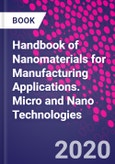Handbook of Nanomaterials for Manufacturing Applications covers the challenges and obstacles involved in using nanomaterials in manufacturing. In particular, the lack of information, the possibility of adverse impacts on the environment, human health, safety and sustainability and other remaining challenges. This book addresses these challenges for the use of nanomaterials in major manufacturing sectors and suggests how they may be overcome. It was written to summarize, in a one-stop, concise manner, how nanomaterials and nanotechnology are being used to enhance current manufacturing techniques and processes in order to create more sustainable products in a range of industry sectors.
This book will be of great use to materials scientists and engineers who are looking to gain a greater understanding on how nanotechnology is being used to improve the products we use in our daily lives.
Please Note: This is an On Demand product, delivery may take up to 11 working days after payment has been received.
Table of Contents
SECTION1: NANOMATERIALS IN INDUSTRIAL MANUFACTURING 1. Manufacturing and Nanomaterials Perspectives 2. Manufacturing and Technology: Perspectives and Enablers
SECTION 2: ENGINEERED NANOMATERIALS IN SURFACES AND COATINGS (Consumer products) 3. Thin Films for Coating Nanomaterials 4. Nanomaterials in detergents and cosmetics products The mechanisms and implications 5. Nanomaterials in coatings: An industrial point of view 6. New nanostructured Ni-W coatings with good corrosion resistance and high hardness 7. Sol-gel surface functionalization regardless of its form and type 8. Engineered nanomaterials for light trapping 9. Nanocapsules: an engineered nanomaterial for smart self-healing coating and catalysis 10. Nanoengineered Sunscreens: Techno-Scientific Breakthrough for Personal Care 11. A cosmeceutical perspective of engineered nanoparticles 12. ActivLayr technology based on marine collagen nanofibres and natural extracts
SECTION 3: ENGINEERED NANOMATERIALS IN THE TEXTILES INDUSTRY 13. Engineered nanoparticles in textiles 14. Nanoparticles and nano fibres used in the textile industry 15. Gas diffusion and relative permeability of nanofibers based on fractal geometry 16. Engineered nanomaterials: Scope in today's textile industry 17. Nanoparticles: a potential alternative to classical fire retardants for textile substrates 18. Fabrication of Polyniline/Carbon nanotube based nanocomposite electrode for detection of organic pollutants 19. Nanoparticles: novel use in bioactive textiles
SECTION 4: ENGINEERED NANOMATERIALS IN THE SPORTS INDUSTRY 20. Segmentation of consumers for nanomaterials-based sports equipment 21. Engineered nanomaterials in the sports industry
SECTION 5: ENGINEERED NANOMATERIALS IN THE AEROSPACE AND VEHICLE INDUSTRIES 22. Modeling of carbon nanotubes and carbon nanotube-polymer composites for aerospace applications 23. Engineered nanomaterials in aerospace 24. Photoconducting polymeric nanocomposites and their application in holographic interferometry 25. Fabrication of nano-sized nickel-based alloys for aerospace engines (Turbine blades)
SECTION 6: ENGINEERED NANOMATERIALS IN THE CONSTRUCTION INDUSTRY 26. Use of engineered nanomaterials in the construction industry: paints and their flows in construction and demolition waste 27. Synthesis, design and characterization of controlled nanoparticles for the construction industry
SECTION 7: ENGINEERED NANOMATERIALS IN THE WOOD INDUSTRY 28. Non-linear release dynamics for a CeO2 nanomaterial embedded in a protective wood stain, due to matrix photo-degradation 29. Application of Nanocellulose (NC) in the paper industry
SECTION 8: ENGINEERED NANOMATERIALS AND ADDITIVE MANUFACTURING (AM) 30. Processing of nano- and microcapsules for industrial applications 31. Nanomaterials for printing technology: A revolution in industrial manufacturing 32. Nanomaterials as Additives
SECTION 9: NANOMATERIALS IN ELECTRONICS 33. Nanomaterials for Electronics, Optoelectronics, and Bioelectronics 34. Application of nanomaterials in the electronics industry
SECTION 10: NANOMATERIALS FOR POLYMERS & THEIR COMPOSITES 35. Nanofibrillar polymer-polymer and single polymer composites via the 'converting instead of adding' concept Examples of true polymer nanocomposite 36. Application of nanomaterials for polymers�and their composites
SECTION 11: SAFETY RISKS IN THE COMMERCIALIZATION OF NANOMATERIALS 37. Establishing the safety of novel bio-based cellulose nanomaterials for commercialization 38. Risk assessment and toxicity of nanomaterials
SECTION 12: NANOMATERIALS FOR A GREEN AND SUSTAINABLE FUTURE 39. Comparison of tools for the sustainability assessment of nanomaterials 40. Nanotechnology for a sustainable future
CONCLUSIONS 41. Enhancing Manufacturing with Nanomaterials








